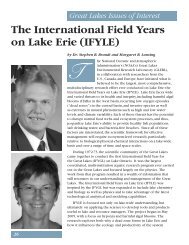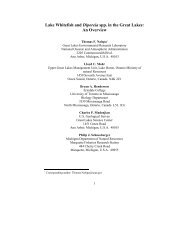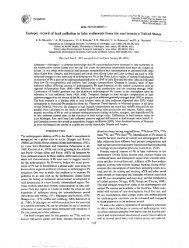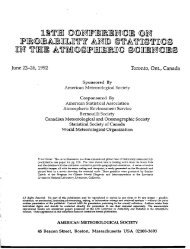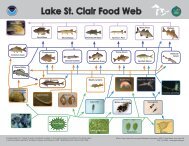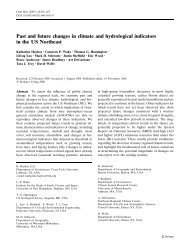Great Lakes Squall! by Walter J. Hoagman. - GLERL
Great Lakes Squall! by Walter J. Hoagman. - GLERL
Great Lakes Squall! by Walter J. Hoagman. - GLERL
Create successful ePaper yourself
Turn your PDF publications into a flip-book with our unique Google optimized e-Paper software.
~ <strong>by</strong> <strong>Walter</strong> J. <strong>Hoagman</strong>,<br />
Michigan Sea Grant Extension Agent<br />
It’s what sailors fear most: the storm from nowhere<br />
that turns quiet seas to rampaging white<br />
caps. The storm that comes out of mist or fog,<br />
hidden <strong>by</strong> the conditions that precede it. I experienced<br />
one firsthand, a big one.<br />
A Near-Fatal Error<br />
When the <strong>Great</strong> Summer Storm of July 13,1995, hit, I<br />
was crossing Lake Huron’s Saginaw Bay with<br />
my wife Athelia and our black lab Bunker in our 24.<br />
foot aluminum cabin cruiser, Misty Blue. Our course<br />
was Caseville (on the Thumb) to Tawas, bearing<br />
directly northwest across 30 miles of open water.<br />
Normally the trip would take about an hour and<br />
fifteen minutes of skimming the water. The conditions<br />
that day were ideal for boating, flat calm and<br />
very warm; but there was a persistent heavy hare.<br />
The horizon was invisible beyond a mile and above it<br />
the sky was white. Normally I make a weather check<br />
before any crossing, but that day I did not, much to<br />
my later regret.<br />
The White <strong>Squall</strong> Advances<br />
We cleared the breakwater just after 4:00, and Athelia<br />
piloted while I attended to chores. We were skipping<br />
along nicely for about 25 minutes when the small TV<br />
antenna started banging the side. We noticed the sky<br />
(haze) ahead getting darker, so I jumped up on the<br />
gunwale to secure the antenna.<br />
<strong>Great</strong> <strong>Lakes</strong> <strong>Squall</strong>!<br />
Then the most unusual thing 1 ever witnessed<br />
in a lifetime of sailing on the <strong>Great</strong> <strong>Lakes</strong> or elsewhere<br />
happened. The sea ahead became suddenly flecked<br />
with white, as if a tremendous school of fish were<br />
thrashing the water. The white zone barreled down<br />
on us at amazing speed. Before Athelia could even<br />
throttle back, the white zone swept past us and the<br />
bow violently slewed off course despite all she could<br />
do. I was still standing on the starboard gunwale,<br />
hanging onto the cabin. The sudden swerve to port<br />
caused me to lose my footing and for an instant I<br />
dangled horizontally, hanging out in space as if I had<br />
tried to grab a moving merry-go-round.<br />
Athelia eased off the speed, and, badly shaken,<br />
I clambered into the cockpit. I will never forget the<br />
view out the windshield. The sky had turned the<br />
deepest purple I’ve ever seen. With the wind accelerating<br />
from zero to frantic in five minutes, the surface<br />
of the water started to heave, the wind blowing the<br />
top off each new wave, the spray a horizontal stream<br />
of hissing water. The wind built up, howling like a<br />
locomotive. I got the Misty Blue headed back into the<br />
waves, and not knowing the size of the system, we<br />
decided to ride it out. We knew we couldn’t outrun<br />
the storm 15 miles back to Caseville anyway.<br />
I
. .<strong>Squall</strong>!<br />
Within 15 minutes, six-foot seas slammed our<br />
boat. Rain poured down so hard the wipers were<br />
nearly useless. It became extremely dark, but blinding<br />
lightning bolts split the gloom every 10-20<br />
seconds. Thunder cracked and rumbled. Every now<br />
and again in life, a person has to say, “&oh,” with<br />
just the precise inflection of fear and apprehension.<br />
We had reached that point. “What in the world did I<br />
get us into now?” I thought, and Bunker must have<br />
thought the same because he curled up in the tightest<br />
ball imaginable and never moved a hair.<br />
Fighting the Storm<br />
Our aluminum boat was seaworthy <strong>by</strong> the barest of<br />
margins. Keeping the Misty Blue’s bow to the seas,<br />
we took on water, but somehow recovered from<br />
wave after wave. Being very light forward, she<br />
smacked each advancing mound with a resounding<br />
shudder, pitched crazily upward, then came down<br />
with a teeth-jarring blam, simultaneously slewing<br />
sideways as the exposed bow caught the racing<br />
wind. It took all my strength to hang on to the wheel<br />
and force her stern back around for the next one.<br />
Water poured in every possible crack and the front<br />
cabin was a shambles of mattresses, duffle bags,<br />
groceries and tableware. The bilge pumps chugged<br />
full-time. We both prayed the hull would<br />
hold, because it had been welded several times and<br />
had many rivets replaced.<br />
Anatomy of a <strong>Squall</strong><br />
The winds continued above 50 mph and<br />
raging seas built into seething whitecaps. 1 kept<br />
thinking, “Gads, this is one heck of a thunderstorm!”<br />
and still the rain poured down. When the wind<br />
finally slacked after about 45 minutes, I got on the<br />
radio and reported our position and situation to the<br />
Tawas Coast Guard, telling them we were all right<br />
but not out of it yet. Bunker hadn’t moved a muscle.<br />
Christmas Tree Effect<br />
Suddenly I felt a cold blast of air from our starboard<br />
beam, flinging all the papers and charts off the dash.<br />
The compass confirmed I was maintaining my<br />
northwest course and the waves were still dead<br />
ahead, but the wind had shifted 90 degrees to the<br />
northeast. It blew violently, and soon the resulting<br />
cross-seas made a real mess of the surface. My only<br />
option was to steer into the northeast wind and hope<br />
we weren’t twisted apart. Within 20 minutes the<br />
confused seas caused opposing breaking crests to<br />
climb one another and smash apart, creating the<br />
“Christmas Tree” effect described <strong>by</strong> some sailors in<br />
<strong>Great</strong> <strong>Lakes</strong> storms. These “trees” were 10 to 12 feet<br />
high, visibility was only 50 to 100 feet, and we really<br />
thought we had bought the farm this time. Both of us<br />
got extremely cold, with goose bumps making us<br />
look like plucked turkeys.<br />
By 6:3O the storm began to ease with the wind<br />
falling below 25 mph, but seas remained at five to<br />
r”,l,imwt~ LOP/ I”‘,qI’ 4<br />
A squall is more than a severe thunderstorm; although these are bad enough. Thunderstorms are usually<br />
scattered, seldom over 5 to 20 miles across, and the violence quickly fades to moderate winds once the<br />
downburst passes. In contrast, a squall line forms from a massive atmospheric disturbance that grows as a<br />
thunderstorm does, but has a rate of advance much higher, packs hundreds of times the energy, and moves as<br />
a wall across land and sea. A squall is its own thing, and of no particular size limit. A large squall can be 30-<br />
100 miles across and move at a ground speed of 50-70 mph.<br />
Some people doubt the existence of anything called a white squall. Over tropical oceans they are fair11<br />
common, but are very rare on the <strong>Great</strong> <strong>Lakes</strong>. Whether a storm is a white squall or not depends on the<br />
strength of the winds. A normal squall line has high winds that roil and whitecap the surface, but a white<br />
squall has hurricane force winds that foam the surface. In sea water, the effect is much more pronounced then<br />
in fresh, but the same thing happens.<br />
A typical severe thunderstorm travels at a rate of 20-30 miles mph, accompanied <strong>by</strong> 40-50 mph winds<br />
that quickly die to 2540 mph. In contrast, we had traveled through an extreme line squall, advancing at 5O-<br />
65 mph, with downburst winds gusting to 80 mph and sustained winds of SO-60 mph. These straight line<br />
winds are called “derechos” <strong>by</strong> meteorologists, and often spawn “gustnados,” swirling funnel clouds created<br />
<strong>by</strong> extreme wind sheer patterns near the ground. These winds toppled up to half-mile tracts of forest across<br />
the Upper Peninsula and Central Michigan, the fallen trees all pointing southeast. The Coast Guard reported<br />
they had answered 183 rescue calls on the <strong>Great</strong> <strong>Lakes</strong> during the passage of the <strong>Great</strong> Storm (the most in one<br />
day ever). -WH
Air Pressure Causes Dramatic Water Level Shift<br />
The <strong>Great</strong> Storm of 1995 caused a dramatic seiche on Lake Huron. Figure 1 shows the barometric pressure<br />
and wind speed recorded at Alpena and Tawas as the storm passed. Figure 2 shows what happened to the<br />
lake level as this pulse traveled across and down the lake. The<br />
64<br />
level change was no mere wind setup, but an<br />
event driven <strong>by</strong> extreme pressure variations on the lake surface. The advancing storm caused a massive pressure<br />
wave that first elevated the water ahead of it, then pushed the water down as the front passed. The pressure then<br />
rapidly decreased below normal, allowing the lake to rock back above its static level. This massive water movement<br />
caused a difference of 45 inches at Goderich, 55 inches at Lakeport, and inches at Port Huron. The rise and<br />
fall at these stations was precisely separated in time <strong>by</strong> the advance of the storm down the lake. The lake then<br />
oscillated up and down through several attenuating cycles, finally returning to “normal” after 12 hours. I finally<br />
had an explanation of the weird events on the dock at Tawas. 1 had missed the press-down while at sea, but caught<br />
the rebound while tying up. --WH
. . . <strong>Squall</strong>!<br />
seven feet. At 700 the sky started to clear and we<br />
spotted the Tawas lighthouse, 12 miles away. Just<br />
then, J. large freighter slid across our port bow,<br />
alarmingly close, heading for open Lake Huron to<br />
the northeast. Soon the Coast Guard came out to look<br />
for us in their 44.footer, and we hailed them and<br />
gave the OK signal. Our engine was plugging along<br />
without a miss, and we were all right after a fashion.<br />
At 8:OO the sun came out, the wind died and we<br />
chugged to the Tawas dock with both pumps<br />
runnmg.<br />
Seiche Nearly Snatches Boat<br />
Athelia grabbed the lines and jumped on the dock<br />
while I headed to the parking lot for the trailer.<br />
When I swung back around to the ramp, I couldn’t<br />
believe my eyes. Athelia was still standing on the<br />
dock, but knee-deep in water, frantically yelling her<br />
head off to hurry. She still gripped the lines but the<br />
tugging currents and eddies were doing their<br />
darndest to snatch the boat away. I leapt out and<br />
threw the lines over the poles in a couple of clove<br />
hitches, and we waded back to the inclined cement<br />
ramp. Within minutes the water fell, exposing the<br />
dock once again. I managed the trailer under Blur<br />
and hauled her up. Once out, she rained bilge water<br />
from dozens of popped rivets and several cracked<br />
seams. We looked at each other in utter amazement.<br />
Driving home, we both shook nearly uncontrollably.<br />
Bunker would not move, eat, or drink for two days!<br />
Lessons Learned<br />
What a day and what a lesson! The most obvious<br />
lesson, as everyone is quick to remind me-why<br />
didn’t I turn on my radio? They are right, I made a<br />
big mistake there, because storm warnings were<br />
broadcast for at least two hours in advance. The<br />
storm’s sire caught everyone <strong>by</strong> surprise, however.<br />
Its swiftness and power may prove it one of the<br />
largest summer storms in this half-century. I don’t<br />
honestly know how we survived the event-dumb<br />
luck 1 guess. Anything could have gone wrong from<br />
a lightning bolt to a busted steering cable. But I’m<br />
still here and even though I may have used up<br />
another one of my nine lives, I hope my story gives<br />
caution to boaters of every ilk that trust their fortunes<br />
to warm sunny days on the lakes. Beware of a<br />
hot hazy day, would be my first caution; anything<br />
can happen.




